Cloud Computing Report - Unit 16: Cloud Computing Analysis
VerifiedAdded on 2021/08/30
|21
|5488
|287
Report
AI Summary
This report provides a comprehensive overview of cloud computing, starting with its basic definitions and benefits, such as cost savings, flexibility, and global deployment. It delves into the different types of cloud computing, including Infrastructure as a Service (IaaS), Platform as a Service (PaaS), and Software as a Service (SaaS). The report also explores the evolution of cloud computing in Vietnam, highlighting its adoption by various organizations. Furthermore, it examines the different deployment models, such as public, private, community, and hybrid clouds, discussing their respective advantages and disadvantages. Finally, the report presents a solution for ATN, outlining the reasons for adopting cloud computing and proposing an architecture and detailed design for its implementation. The report concludes by referencing relevant sources for further study.
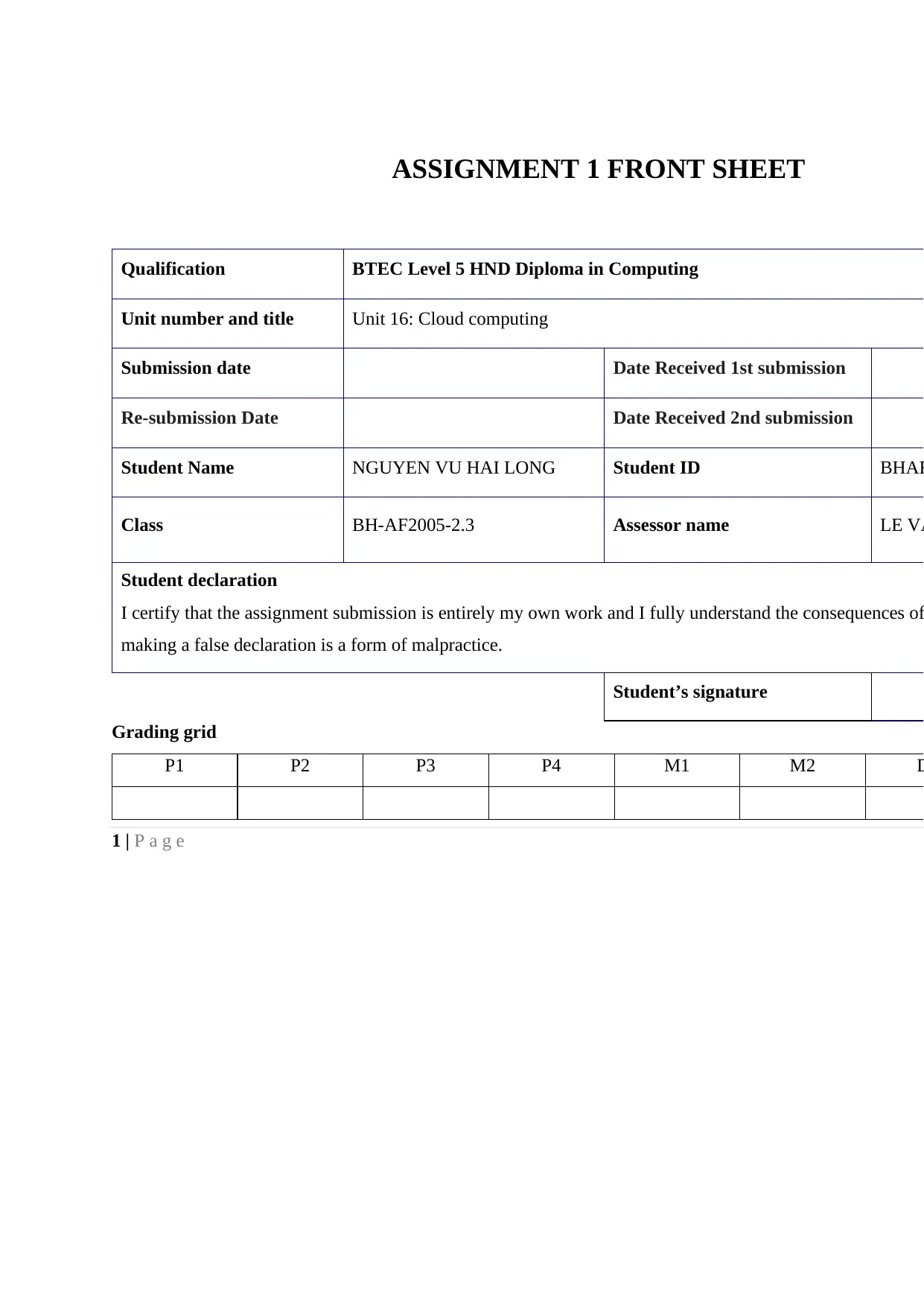
1 | P a g e
ASSIGNMENT 1 FRONT SHEET
Qualification BTEC Level 5 HND Diploma in Computing
Unit number and title Unit 16: Cloud computing
Submission date Date Received 1st submission
Re-submission Date Date Received 2nd submission
Student Name NGUYEN VU HAI LONG Student ID BHAF
Class BH-AF2005-2.3 Assessor name LE VA
Student declaration
I certify that the assignment submission is entirely my own work and I fully understand the consequences of
making a false declaration is a form of malpractice.
Student’s signature
Grading grid
P1 P2 P3 P4 M1 M2 D
ASSIGNMENT 1 FRONT SHEET
Qualification BTEC Level 5 HND Diploma in Computing
Unit number and title Unit 16: Cloud computing
Submission date Date Received 1st submission
Re-submission Date Date Received 2nd submission
Student Name NGUYEN VU HAI LONG Student ID BHAF
Class BH-AF2005-2.3 Assessor name LE VA
Student declaration
I certify that the assignment submission is entirely my own work and I fully understand the consequences of
making a false declaration is a form of malpractice.
Student’s signature
Grading grid
P1 P2 P3 P4 M1 M2 D
Paraphrase This Document
Need a fresh take? Get an instant paraphrase of this document with our AI Paraphraser
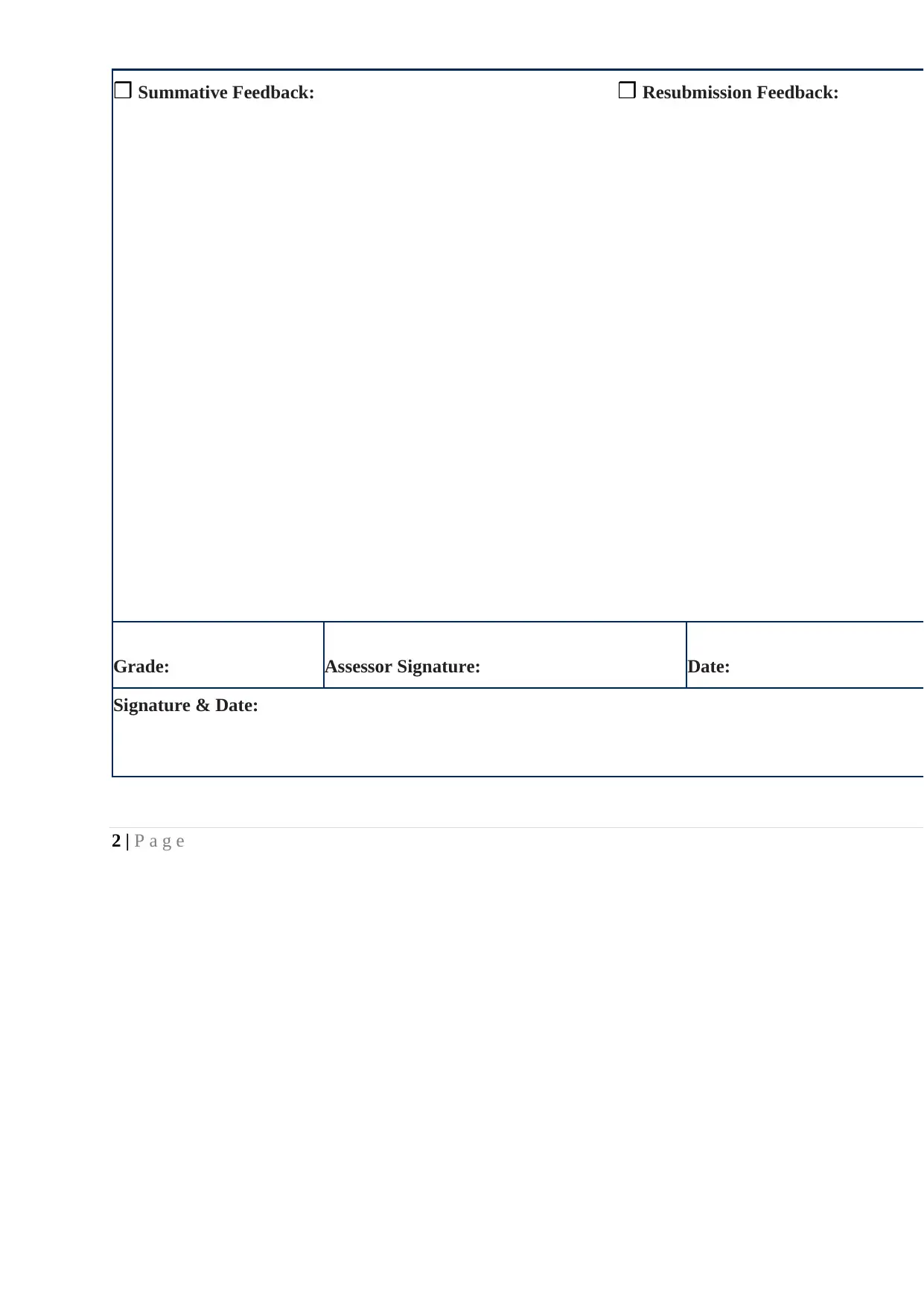
2 | P a g e
❒ Summative Feedback: ❒ Resubmission Feedback:
Grade: Assessor Signature: Date:
Signature & Date:
❒ Summative Feedback: ❒ Resubmission Feedback:
Grade: Assessor Signature: Date:
Signature & Date:
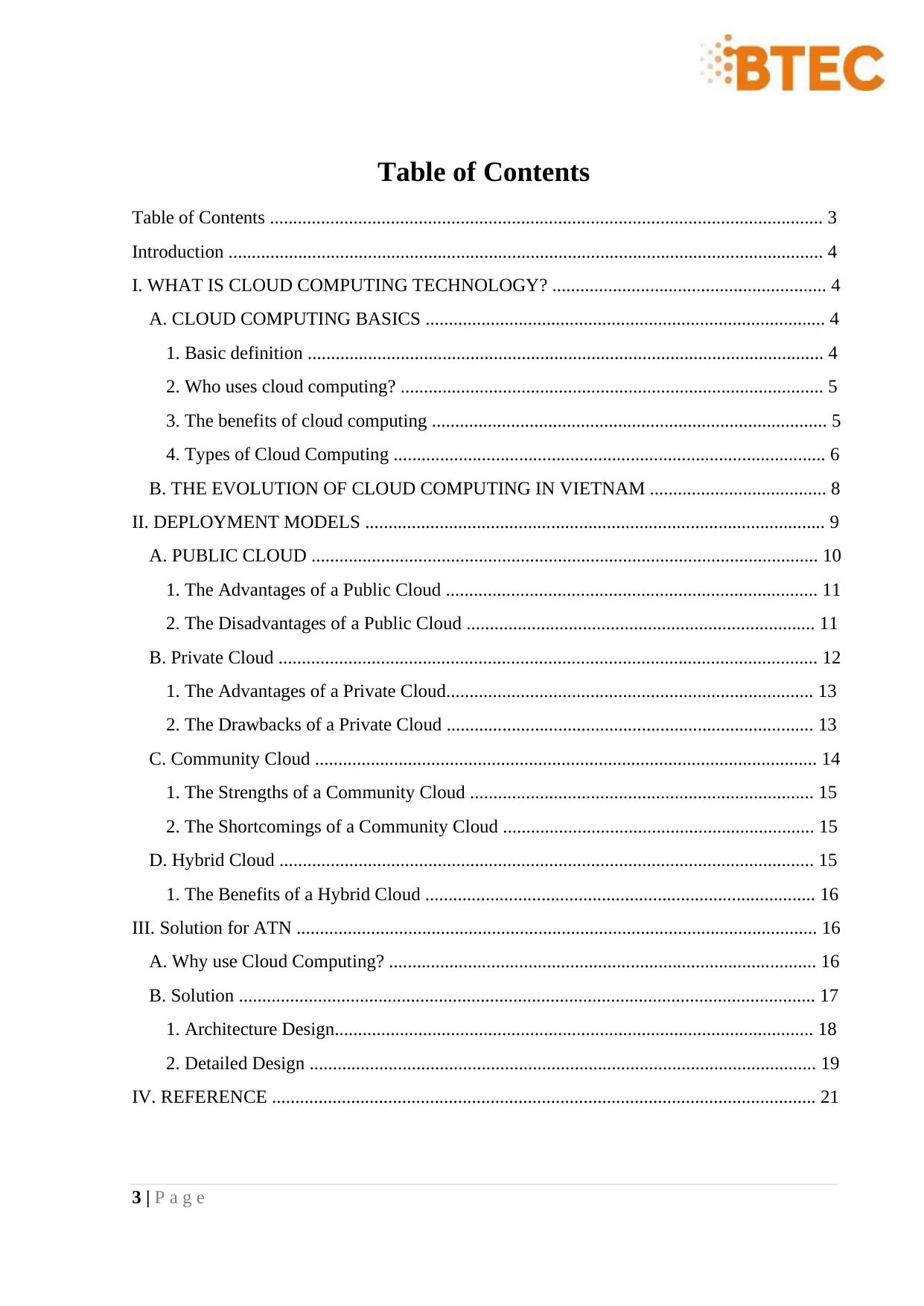
3 | P a g e
Table of Contents
Table of Contents ....................................................................................................................... 3
Introduction ................................................................................................................................ 4
I. WHAT IS CLOUD COMPUTING TECHNOLOGY? ........................................................... 4
A. CLOUD COMPUTING BASICS ...................................................................................... 4
1. Basic definition ............................................................................................................... 4
2. Who uses cloud computing? ........................................................................................... 5
3. The benefits of cloud computing ..................................................................................... 5
4. Types of Cloud Computing ............................................................................................. 6
B. THE EVOLUTION OF CLOUD COMPUTING IN VIETNAM ...................................... 8
II. DEPLOYMENT MODELS ................................................................................................... 9
A. PUBLIC CLOUD ............................................................................................................. 10
1. The Advantages of a Public Cloud ................................................................................ 11
2. The Disadvantages of a Public Cloud ........................................................................... 11
B. Private Cloud .................................................................................................................... 12
1. The Advantages of a Private Cloud............................................................................... 13
2. The Drawbacks of a Private Cloud ............................................................................... 13
C. Community Cloud ............................................................................................................ 14
1. The Strengths of a Community Cloud .......................................................................... 15
2. The Shortcomings of a Community Cloud ................................................................... 15
D. Hybrid Cloud ................................................................................................................... 15
1. The Benefits of a Hybrid Cloud .................................................................................... 16
III. Solution for ATN ................................................................................................................ 16
A. Why use Cloud Computing? ............................................................................................ 16
B. Solution ............................................................................................................................ 17
1. Architecture Design....................................................................................................... 18
2. Detailed Design ............................................................................................................. 19
IV. REFERENCE ..................................................................................................................... 21
Table of Contents
Table of Contents ....................................................................................................................... 3
Introduction ................................................................................................................................ 4
I. WHAT IS CLOUD COMPUTING TECHNOLOGY? ........................................................... 4
A. CLOUD COMPUTING BASICS ...................................................................................... 4
1. Basic definition ............................................................................................................... 4
2. Who uses cloud computing? ........................................................................................... 5
3. The benefits of cloud computing ..................................................................................... 5
4. Types of Cloud Computing ............................................................................................. 6
B. THE EVOLUTION OF CLOUD COMPUTING IN VIETNAM ...................................... 8
II. DEPLOYMENT MODELS ................................................................................................... 9
A. PUBLIC CLOUD ............................................................................................................. 10
1. The Advantages of a Public Cloud ................................................................................ 11
2. The Disadvantages of a Public Cloud ........................................................................... 11
B. Private Cloud .................................................................................................................... 12
1. The Advantages of a Private Cloud............................................................................... 13
2. The Drawbacks of a Private Cloud ............................................................................... 13
C. Community Cloud ............................................................................................................ 14
1. The Strengths of a Community Cloud .......................................................................... 15
2. The Shortcomings of a Community Cloud ................................................................... 15
D. Hybrid Cloud ................................................................................................................... 15
1. The Benefits of a Hybrid Cloud .................................................................................... 16
III. Solution for ATN ................................................................................................................ 16
A. Why use Cloud Computing? ............................................................................................ 16
B. Solution ............................................................................................................................ 17
1. Architecture Design....................................................................................................... 18
2. Detailed Design ............................................................................................................. 19
IV. REFERENCE ..................................................................................................................... 21
⊘ This is a preview!⊘
Do you want full access?
Subscribe today to unlock all pages.

Trusted by 1+ million students worldwide
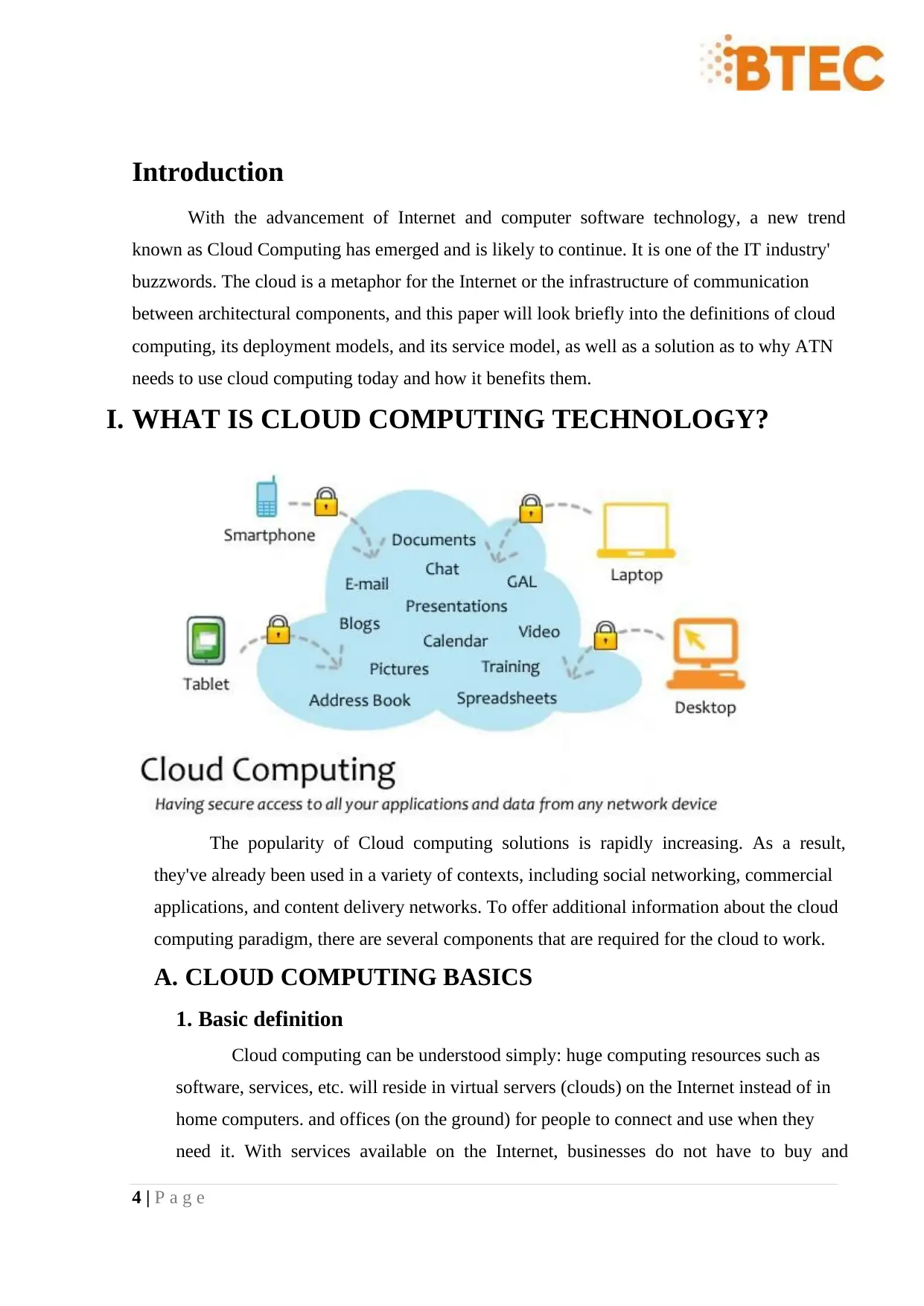
4 | P a g e
Introduction
With the advancement of Internet and computer software technology, a new trend
known as Cloud Computing has emerged and is likely to continue. It is one of the IT industry'
buzzwords. The cloud is a metaphor for the Internet or the infrastructure of communication
between architectural components, and this paper will look briefly into the definitions of cloud
computing, its deployment models, and its service model, as well as a solution as to why ATN
needs to use cloud computing today and how it benefits them.
I. WHAT IS CLOUD COMPUTING TECHNOLOGY?
The popularity of Cloud computing solutions is rapidly increasing. As a result,
they've already been used in a variety of contexts, including social networking, commercial
applications, and content delivery networks. To offer additional information about the cloud
computing paradigm, there are several components that are required for the cloud to work.
A. CLOUD COMPUTING BASICS
1. Basic definition
Cloud computing can be understood simply: huge computing resources such as
software, services, etc. will reside in virtual servers (clouds) on the Internet instead of in
home computers. and offices (on the ground) for people to connect and use when they
need it. With services available on the Internet, businesses do not have to buy and
Introduction
With the advancement of Internet and computer software technology, a new trend
known as Cloud Computing has emerged and is likely to continue. It is one of the IT industry'
buzzwords. The cloud is a metaphor for the Internet or the infrastructure of communication
between architectural components, and this paper will look briefly into the definitions of cloud
computing, its deployment models, and its service model, as well as a solution as to why ATN
needs to use cloud computing today and how it benefits them.
I. WHAT IS CLOUD COMPUTING TECHNOLOGY?
The popularity of Cloud computing solutions is rapidly increasing. As a result,
they've already been used in a variety of contexts, including social networking, commercial
applications, and content delivery networks. To offer additional information about the cloud
computing paradigm, there are several components that are required for the cloud to work.
A. CLOUD COMPUTING BASICS
1. Basic definition
Cloud computing can be understood simply: huge computing resources such as
software, services, etc. will reside in virtual servers (clouds) on the Internet instead of in
home computers. and offices (on the ground) for people to connect and use when they
need it. With services available on the Internet, businesses do not have to buy and
Paraphrase This Document
Need a fresh take? Get an instant paraphrase of this document with our AI Paraphraser
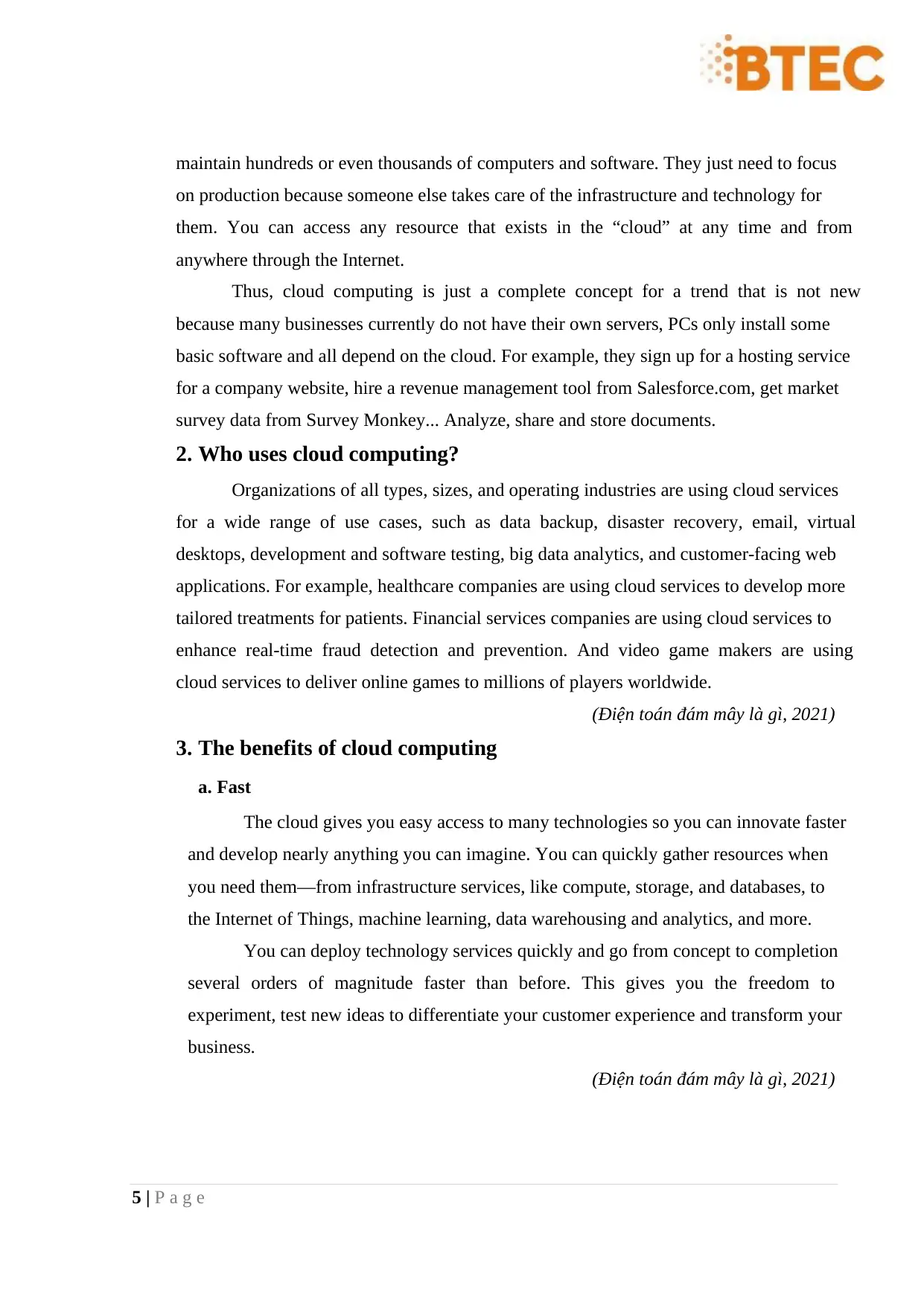
5 | P a g e
maintain hundreds or even thousands of computers and software. They just need to focus
on production because someone else takes care of the infrastructure and technology for
them. You can access any resource that exists in the “cloud” at any time and from
anywhere through the Internet.
Thus, cloud computing is just a complete concept for a trend that is not new
because many businesses currently do not have their own servers, PCs only install some
basic software and all depend on the cloud. For example, they sign up for a hosting service
for a company website, hire a revenue management tool from Salesforce.com, get market
survey data from Survey Monkey... Analyze, share and store documents.
2. Who uses cloud computing?
Organizations of all types, sizes, and operating industries are using cloud services
for a wide range of use cases, such as data backup, disaster recovery, email, virtual
desktops, development and software testing, big data analytics, and customer-facing web
applications. For example, healthcare companies are using cloud services to develop more
tailored treatments for patients. Financial services companies are using cloud services to
enhance real-time fraud detection and prevention. And video game makers are using
cloud services to deliver online games to millions of players worldwide.
(Điện toán đám mây là gì, 2021)
3. The benefits of cloud computing
a. Fast
The cloud gives you easy access to many technologies so you can innovate faster
and develop nearly anything you can imagine. You can quickly gather resources when
you need them—from infrastructure services, like compute, storage, and databases, to
the Internet of Things, machine learning, data warehousing and analytics, and more.
You can deploy technology services quickly and go from concept to completion
several orders of magnitude faster than before. This gives you the freedom to
experiment, test new ideas to differentiate your customer experience and transform your
business.
(Điện toán đám mây là gì, 2021)
maintain hundreds or even thousands of computers and software. They just need to focus
on production because someone else takes care of the infrastructure and technology for
them. You can access any resource that exists in the “cloud” at any time and from
anywhere through the Internet.
Thus, cloud computing is just a complete concept for a trend that is not new
because many businesses currently do not have their own servers, PCs only install some
basic software and all depend on the cloud. For example, they sign up for a hosting service
for a company website, hire a revenue management tool from Salesforce.com, get market
survey data from Survey Monkey... Analyze, share and store documents.
2. Who uses cloud computing?
Organizations of all types, sizes, and operating industries are using cloud services
for a wide range of use cases, such as data backup, disaster recovery, email, virtual
desktops, development and software testing, big data analytics, and customer-facing web
applications. For example, healthcare companies are using cloud services to develop more
tailored treatments for patients. Financial services companies are using cloud services to
enhance real-time fraud detection and prevention. And video game makers are using
cloud services to deliver online games to millions of players worldwide.
(Điện toán đám mây là gì, 2021)
3. The benefits of cloud computing
a. Fast
The cloud gives you easy access to many technologies so you can innovate faster
and develop nearly anything you can imagine. You can quickly gather resources when
you need them—from infrastructure services, like compute, storage, and databases, to
the Internet of Things, machine learning, data warehousing and analytics, and more.
You can deploy technology services quickly and go from concept to completion
several orders of magnitude faster than before. This gives you the freedom to
experiment, test new ideas to differentiate your customer experience and transform your
business.
(Điện toán đám mây là gì, 2021)
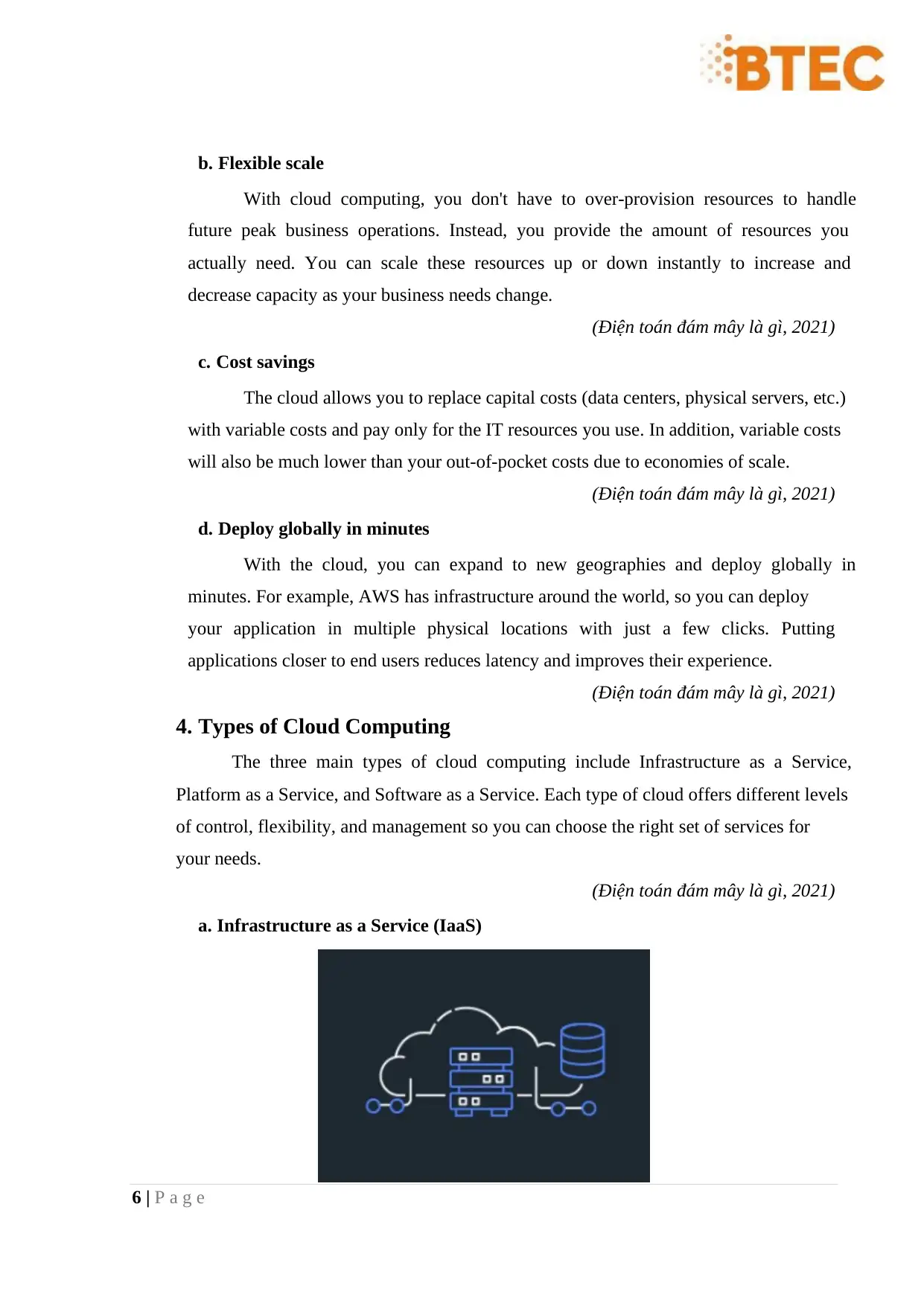
6 | P a g e
b. Flexible scale
With cloud computing, you don't have to over-provision resources to handle
future peak business operations. Instead, you provide the amount of resources you
actually need. You can scale these resources up or down instantly to increase and
decrease capacity as your business needs change.
(Điện toán đám mây là gì, 2021)
c. Cost savings
The cloud allows you to replace capital costs (data centers, physical servers, etc.)
with variable costs and pay only for the IT resources you use. In addition, variable costs
will also be much lower than your out-of-pocket costs due to economies of scale.
(Điện toán đám mây là gì, 2021)
d. Deploy globally in minutes
With the cloud, you can expand to new geographies and deploy globally in
minutes. For example, AWS has infrastructure around the world, so you can deploy
your application in multiple physical locations with just a few clicks. Putting
applications closer to end users reduces latency and improves their experience.
(Điện toán đám mây là gì, 2021)
4. Types of Cloud Computing
The three main types of cloud computing include Infrastructure as a Service,
Platform as a Service, and Software as a Service. Each type of cloud offers different levels
of control, flexibility, and management so you can choose the right set of services for
your needs.
(Điện toán đám mây là gì, 2021)
a. Infrastructure as a Service (IaaS)
b. Flexible scale
With cloud computing, you don't have to over-provision resources to handle
future peak business operations. Instead, you provide the amount of resources you
actually need. You can scale these resources up or down instantly to increase and
decrease capacity as your business needs change.
(Điện toán đám mây là gì, 2021)
c. Cost savings
The cloud allows you to replace capital costs (data centers, physical servers, etc.)
with variable costs and pay only for the IT resources you use. In addition, variable costs
will also be much lower than your out-of-pocket costs due to economies of scale.
(Điện toán đám mây là gì, 2021)
d. Deploy globally in minutes
With the cloud, you can expand to new geographies and deploy globally in
minutes. For example, AWS has infrastructure around the world, so you can deploy
your application in multiple physical locations with just a few clicks. Putting
applications closer to end users reduces latency and improves their experience.
(Điện toán đám mây là gì, 2021)
4. Types of Cloud Computing
The three main types of cloud computing include Infrastructure as a Service,
Platform as a Service, and Software as a Service. Each type of cloud offers different levels
of control, flexibility, and management so you can choose the right set of services for
your needs.
(Điện toán đám mây là gì, 2021)
a. Infrastructure as a Service (IaaS)
⊘ This is a preview!⊘
Do you want full access?
Subscribe today to unlock all pages.

Trusted by 1+ million students worldwide
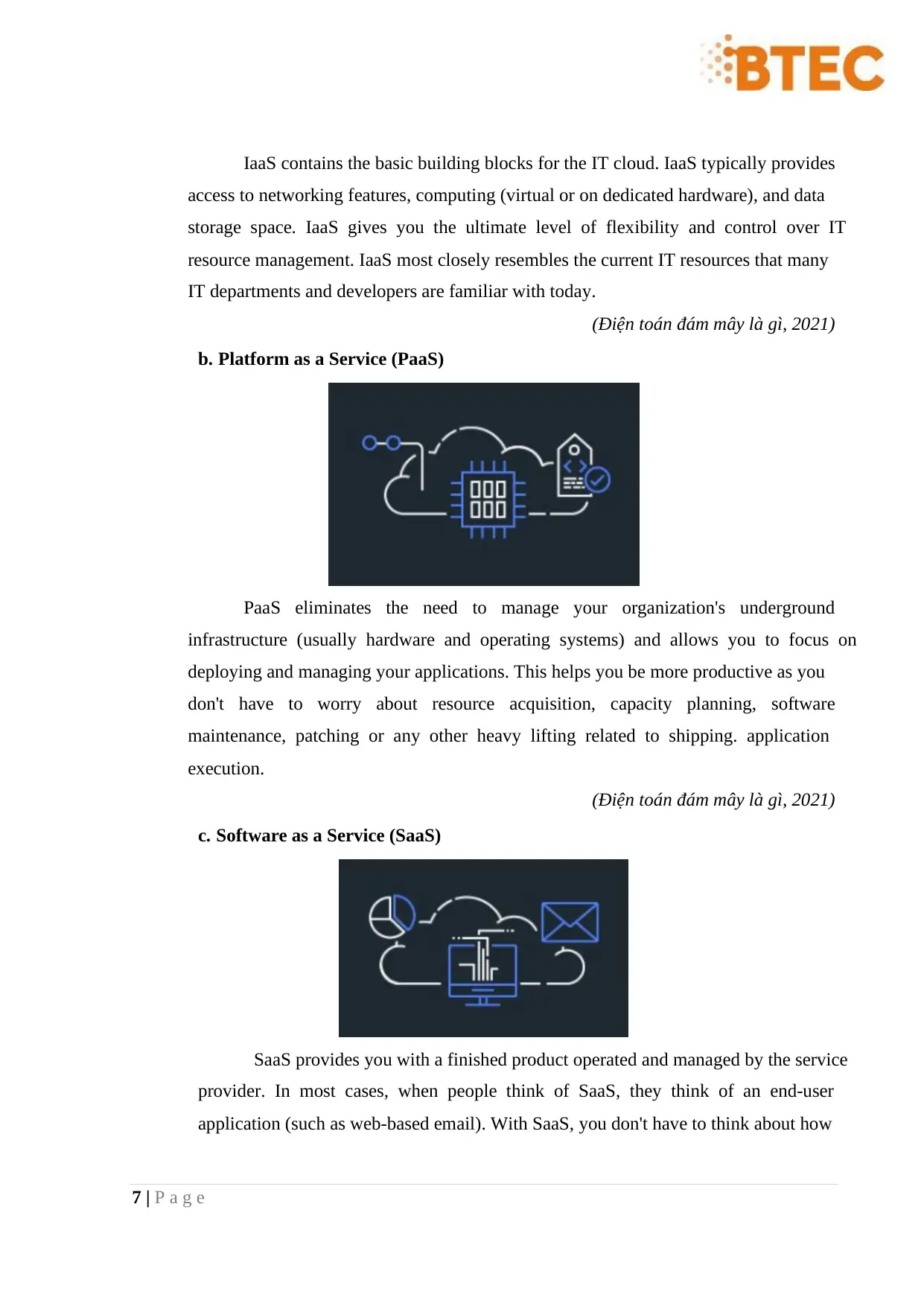
7 | P a g e
IaaS contains the basic building blocks for the IT cloud. IaaS typically provides
access to networking features, computing (virtual or on dedicated hardware), and data
storage space. IaaS gives you the ultimate level of flexibility and control over IT
resource management. IaaS most closely resembles the current IT resources that many
IT departments and developers are familiar with today.
(Điện toán đám mây là gì, 2021)
b. Platform as a Service (PaaS)
PaaS eliminates the need to manage your organization's underground
infrastructure (usually hardware and operating systems) and allows you to focus on
deploying and managing your applications. This helps you be more productive as you
don't have to worry about resource acquisition, capacity planning, software
maintenance, patching or any other heavy lifting related to shipping. application
execution.
(Điện toán đám mây là gì, 2021)
c. Software as a Service (SaaS)
SaaS provides you with a finished product operated and managed by the service
provider. In most cases, when people think of SaaS, they think of an end-user
application (such as web-based email). With SaaS, you don't have to think about how
IaaS contains the basic building blocks for the IT cloud. IaaS typically provides
access to networking features, computing (virtual or on dedicated hardware), and data
storage space. IaaS gives you the ultimate level of flexibility and control over IT
resource management. IaaS most closely resembles the current IT resources that many
IT departments and developers are familiar with today.
(Điện toán đám mây là gì, 2021)
b. Platform as a Service (PaaS)
PaaS eliminates the need to manage your organization's underground
infrastructure (usually hardware and operating systems) and allows you to focus on
deploying and managing your applications. This helps you be more productive as you
don't have to worry about resource acquisition, capacity planning, software
maintenance, patching or any other heavy lifting related to shipping. application
execution.
(Điện toán đám mây là gì, 2021)
c. Software as a Service (SaaS)
SaaS provides you with a finished product operated and managed by the service
provider. In most cases, when people think of SaaS, they think of an end-user
application (such as web-based email). With SaaS, you don't have to think about how
Paraphrase This Document
Need a fresh take? Get an instant paraphrase of this document with our AI Paraphraser
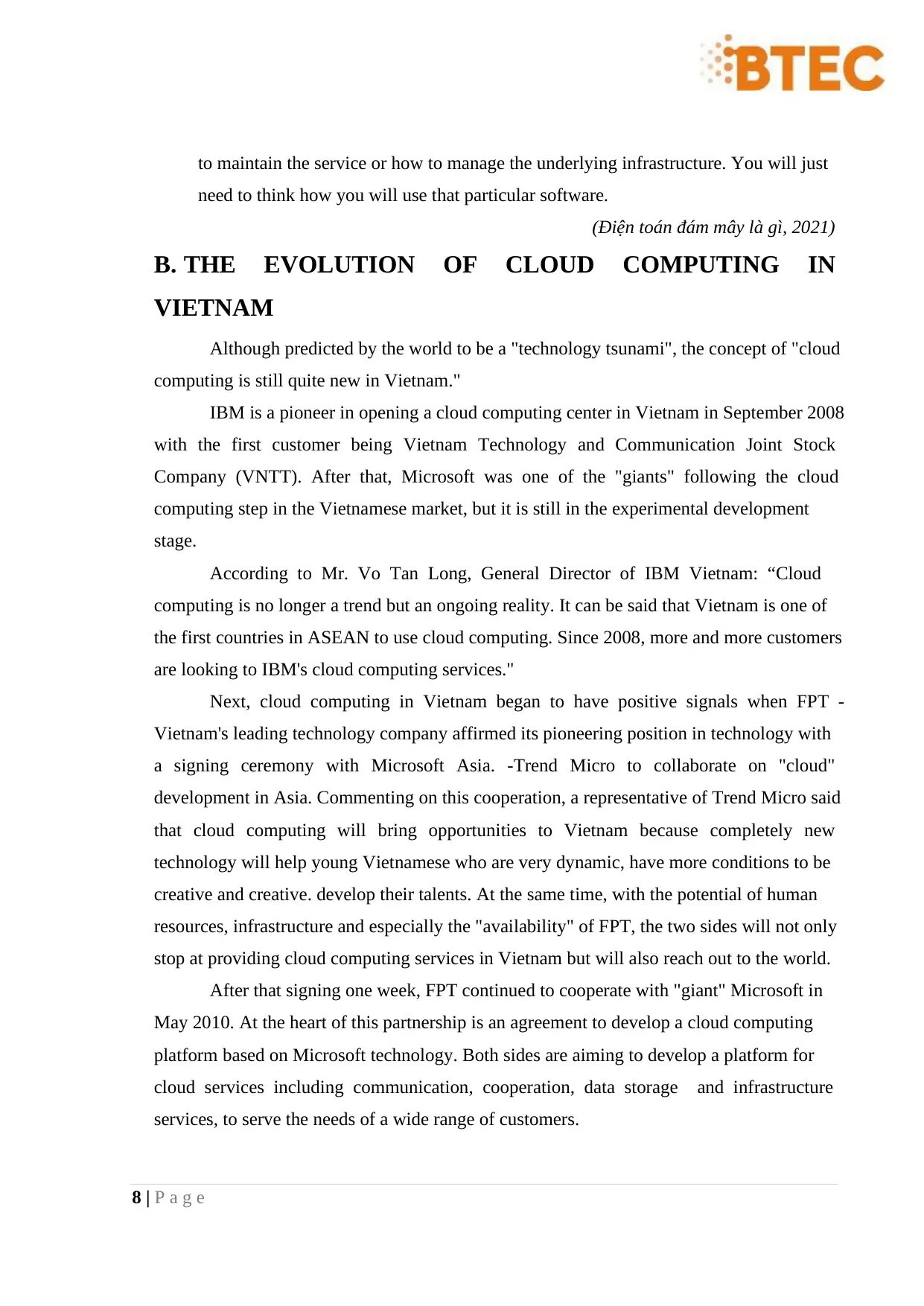
8 | P a g e
to maintain the service or how to manage the underlying infrastructure. You will just
need to think how you will use that particular software.
(Điện toán đám mây là gì, 2021)
B. THE EVOLUTION OF CLOUD COMPUTING IN
VIETNAM
Although predicted by the world to be a "technology tsunami", the concept of "cloud
computing is still quite new in Vietnam."
IBM is a pioneer in opening a cloud computing center in Vietnam in September 2008
with the first customer being Vietnam Technology and Communication Joint Stock
Company (VNTT). After that, Microsoft was one of the "giants" following the cloud
computing step in the Vietnamese market, but it is still in the experimental development
stage.
According to Mr. Vo Tan Long, General Director of IBM Vietnam: “Cloud
computing is no longer a trend but an ongoing reality. It can be said that Vietnam is one of
the first countries in ASEAN to use cloud computing. Since 2008, more and more customers
are looking to IBM's cloud computing services."
Next, cloud computing in Vietnam began to have positive signals when FPT -
Vietnam's leading technology company affirmed its pioneering position in technology with
a signing ceremony with Microsoft Asia. -Trend Micro to collaborate on "cloud"
development in Asia. Commenting on this cooperation, a representative of Trend Micro said
that cloud computing will bring opportunities to Vietnam because completely new
technology will help young Vietnamese who are very dynamic, have more conditions to be
creative and creative. develop their talents. At the same time, with the potential of human
resources, infrastructure and especially the "availability" of FPT, the two sides will not only
stop at providing cloud computing services in Vietnam but will also reach out to the world.
After that signing one week, FPT continued to cooperate with "giant" Microsoft in
May 2010. At the heart of this partnership is an agreement to develop a cloud computing
platform based on Microsoft technology. Both sides are aiming to develop a platform for
cloud services including communication, cooperation, data storage and infrastructure
services, to serve the needs of a wide range of customers.
to maintain the service or how to manage the underlying infrastructure. You will just
need to think how you will use that particular software.
(Điện toán đám mây là gì, 2021)
B. THE EVOLUTION OF CLOUD COMPUTING IN
VIETNAM
Although predicted by the world to be a "technology tsunami", the concept of "cloud
computing is still quite new in Vietnam."
IBM is a pioneer in opening a cloud computing center in Vietnam in September 2008
with the first customer being Vietnam Technology and Communication Joint Stock
Company (VNTT). After that, Microsoft was one of the "giants" following the cloud
computing step in the Vietnamese market, but it is still in the experimental development
stage.
According to Mr. Vo Tan Long, General Director of IBM Vietnam: “Cloud
computing is no longer a trend but an ongoing reality. It can be said that Vietnam is one of
the first countries in ASEAN to use cloud computing. Since 2008, more and more customers
are looking to IBM's cloud computing services."
Next, cloud computing in Vietnam began to have positive signals when FPT -
Vietnam's leading technology company affirmed its pioneering position in technology with
a signing ceremony with Microsoft Asia. -Trend Micro to collaborate on "cloud"
development in Asia. Commenting on this cooperation, a representative of Trend Micro said
that cloud computing will bring opportunities to Vietnam because completely new
technology will help young Vietnamese who are very dynamic, have more conditions to be
creative and creative. develop their talents. At the same time, with the potential of human
resources, infrastructure and especially the "availability" of FPT, the two sides will not only
stop at providing cloud computing services in Vietnam but will also reach out to the world.
After that signing one week, FPT continued to cooperate with "giant" Microsoft in
May 2010. At the heart of this partnership is an agreement to develop a cloud computing
platform based on Microsoft technology. Both sides are aiming to develop a platform for
cloud services including communication, cooperation, data storage and infrastructure
services, to serve the needs of a wide range of customers.
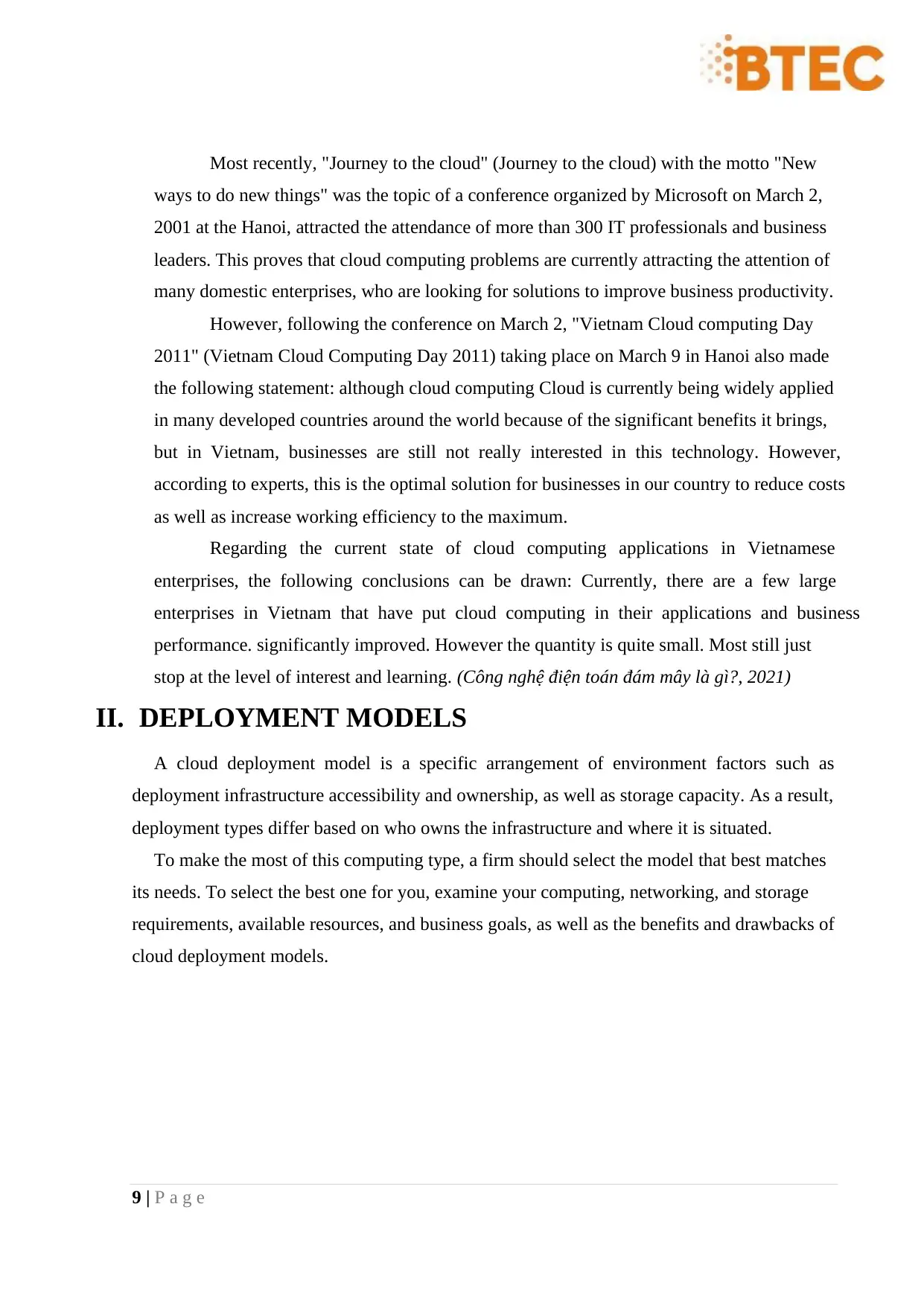
9 | P a g e
Most recently, "Journey to the cloud" (Journey to the cloud) with the motto "New
ways to do new things" was the topic of a conference organized by Microsoft on March 2,
2001 at the Hanoi, attracted the attendance of more than 300 IT professionals and business
leaders. This proves that cloud computing problems are currently attracting the attention of
many domestic enterprises, who are looking for solutions to improve business productivity.
However, following the conference on March 2, "Vietnam Cloud computing Day
2011" (Vietnam Cloud Computing Day 2011) taking place on March 9 in Hanoi also made
the following statement: although cloud computing Cloud is currently being widely applied
in many developed countries around the world because of the significant benefits it brings,
but in Vietnam, businesses are still not really interested in this technology. However,
according to experts, this is the optimal solution for businesses in our country to reduce costs
as well as increase working efficiency to the maximum.
Regarding the current state of cloud computing applications in Vietnamese
enterprises, the following conclusions can be drawn: Currently, there are a few large
enterprises in Vietnam that have put cloud computing in their applications and business
performance. significantly improved. However the quantity is quite small. Most still just
stop at the level of interest and learning. (Công nghệ điện toán đám mây là gì?, 2021)
II. DEPLOYMENT MODELS
A cloud deployment model is a specific arrangement of environment factors such as
deployment infrastructure accessibility and ownership, as well as storage capacity. As a result,
deployment types differ based on who owns the infrastructure and where it is situated.
To make the most of this computing type, a firm should select the model that best matches
its needs. To select the best one for you, examine your computing, networking, and storage
requirements, available resources, and business goals, as well as the benefits and drawbacks of
cloud deployment models.
Most recently, "Journey to the cloud" (Journey to the cloud) with the motto "New
ways to do new things" was the topic of a conference organized by Microsoft on March 2,
2001 at the Hanoi, attracted the attendance of more than 300 IT professionals and business
leaders. This proves that cloud computing problems are currently attracting the attention of
many domestic enterprises, who are looking for solutions to improve business productivity.
However, following the conference on March 2, "Vietnam Cloud computing Day
2011" (Vietnam Cloud Computing Day 2011) taking place on March 9 in Hanoi also made
the following statement: although cloud computing Cloud is currently being widely applied
in many developed countries around the world because of the significant benefits it brings,
but in Vietnam, businesses are still not really interested in this technology. However,
according to experts, this is the optimal solution for businesses in our country to reduce costs
as well as increase working efficiency to the maximum.
Regarding the current state of cloud computing applications in Vietnamese
enterprises, the following conclusions can be drawn: Currently, there are a few large
enterprises in Vietnam that have put cloud computing in their applications and business
performance. significantly improved. However the quantity is quite small. Most still just
stop at the level of interest and learning. (Công nghệ điện toán đám mây là gì?, 2021)
II. DEPLOYMENT MODELS
A cloud deployment model is a specific arrangement of environment factors such as
deployment infrastructure accessibility and ownership, as well as storage capacity. As a result,
deployment types differ based on who owns the infrastructure and where it is situated.
To make the most of this computing type, a firm should select the model that best matches
its needs. To select the best one for you, examine your computing, networking, and storage
requirements, available resources, and business goals, as well as the benefits and drawbacks of
cloud deployment models.
⊘ This is a preview!⊘
Do you want full access?
Subscribe today to unlock all pages.

Trusted by 1+ million students worldwide
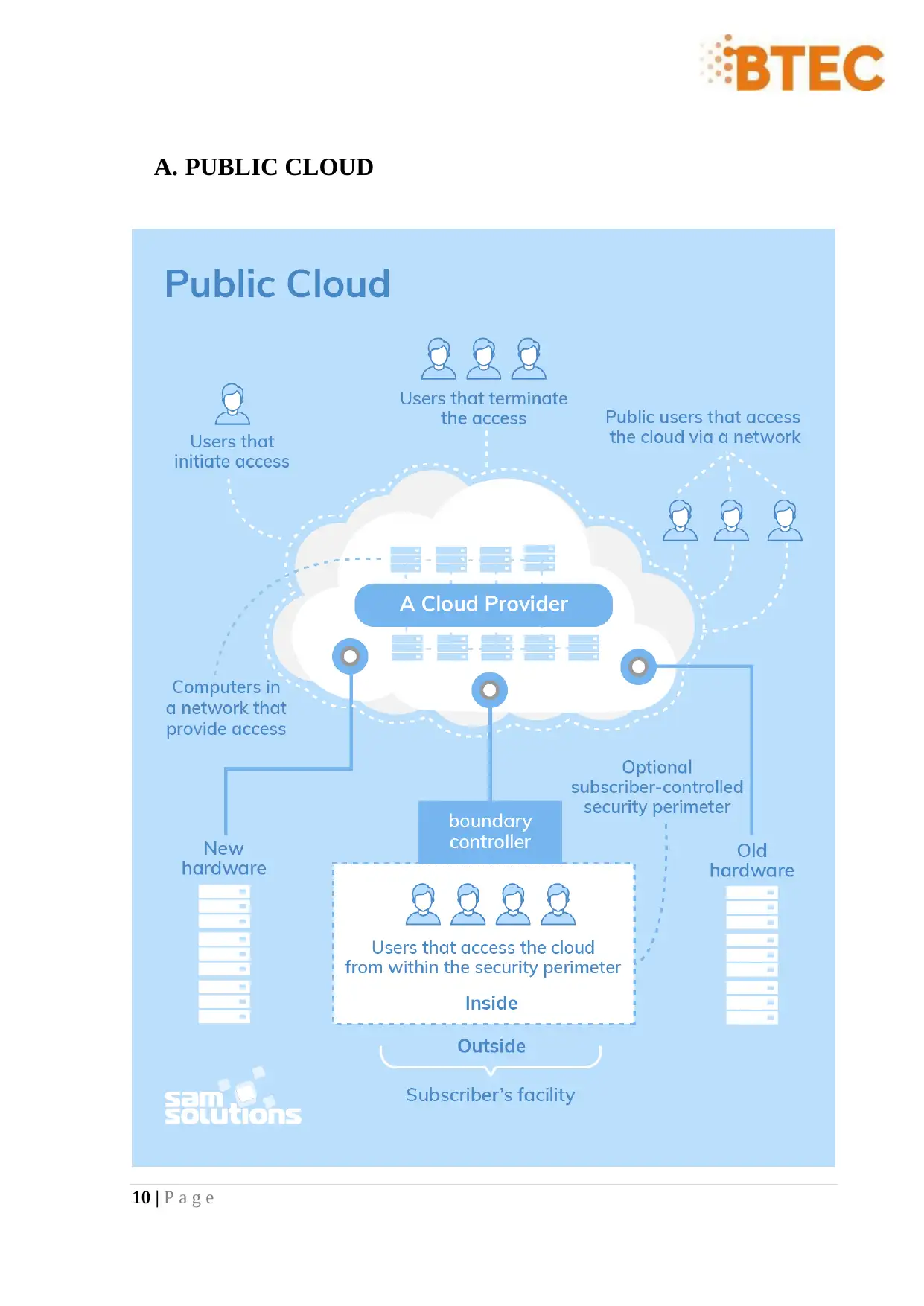
10 | P a g e
A. PUBLIC CLOUD
A. PUBLIC CLOUD
Paraphrase This Document
Need a fresh take? Get an instant paraphrase of this document with our AI Paraphraser
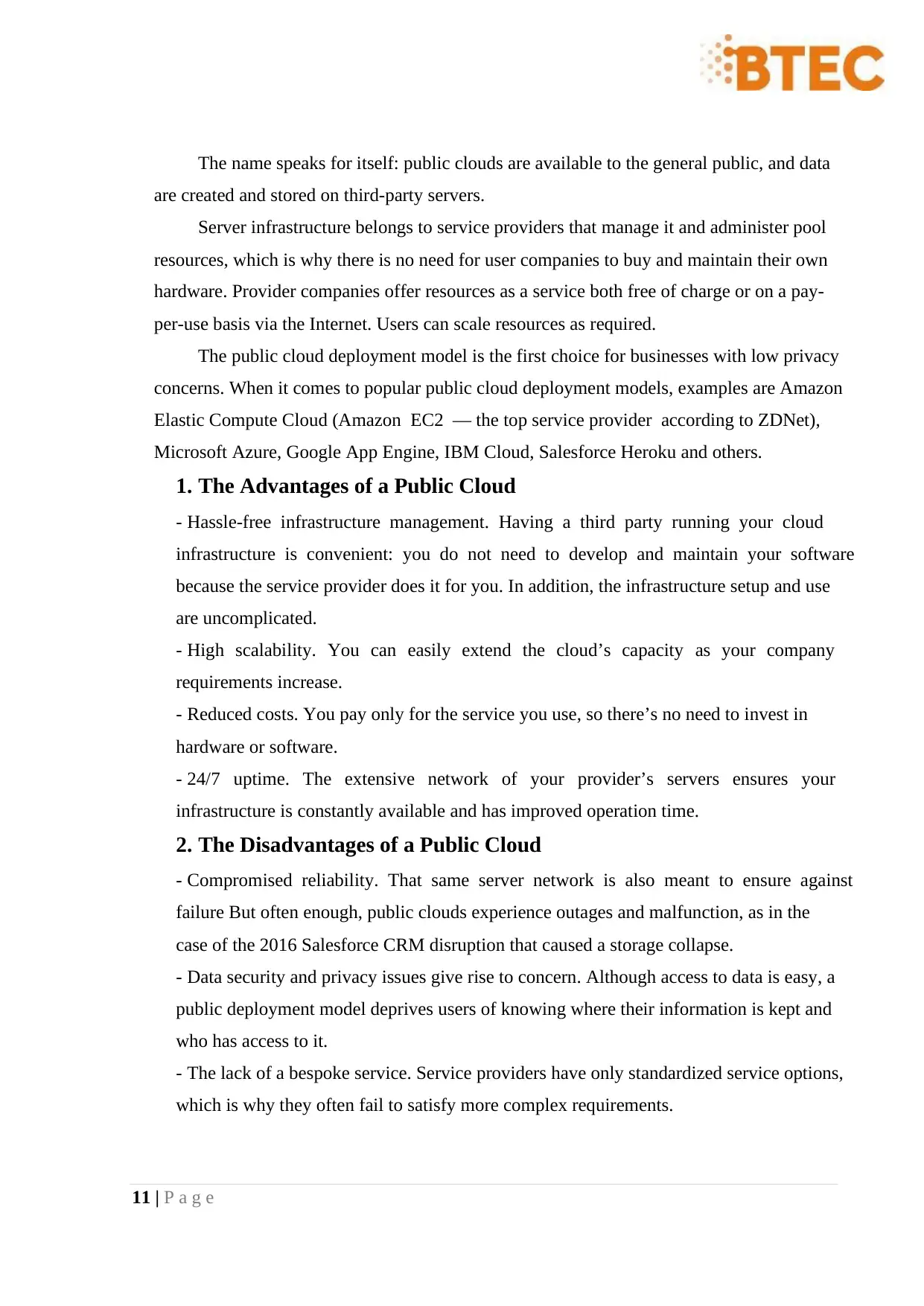
11 | P a g e
The name speaks for itself: public clouds are available to the general public, and data
are created and stored on third-party servers.
Server infrastructure belongs to service providers that manage it and administer pool
resources, which is why there is no need for user companies to buy and maintain their own
hardware. Provider companies offer resources as a service both free of charge or on a pay-
per-use basis via the Internet. Users can scale resources as required.
The public cloud deployment model is the first choice for businesses with low privacy
concerns. When it comes to popular public cloud deployment models, examples are Amazon
Elastic Compute Cloud (Amazon EC2 — the top service provider according to ZDNet),
Microsoft Azure, Google App Engine, IBM Cloud, Salesforce Heroku and others.
1. The Advantages of a Public Cloud
- Hassle-free infrastructure management. Having a third party running your cloud
infrastructure is convenient: you do not need to develop and maintain your software
because the service provider does it for you. In addition, the infrastructure setup and use
are uncomplicated.
- High scalability. You can easily extend the cloud’s capacity as your company
requirements increase.
- Reduced costs. You pay only for the service you use, so there’s no need to invest in
hardware or software.
- 24/7 uptime. The extensive network of your provider’s servers ensures your
infrastructure is constantly available and has improved operation time.
2. The Disadvantages of a Public Cloud
- Compromised reliability. That same server network is also meant to ensure against
failure But often enough, public clouds experience outages and malfunction, as in the
case of the 2016 Salesforce CRM disruption that caused a storage collapse.
- Data security and privacy issues give rise to concern. Although access to data is easy, a
public deployment model deprives users of knowing where their information is kept and
who has access to it.
- The lack of a bespoke service. Service providers have only standardized service options,
which is why they often fail to satisfy more complex requirements.
The name speaks for itself: public clouds are available to the general public, and data
are created and stored on third-party servers.
Server infrastructure belongs to service providers that manage it and administer pool
resources, which is why there is no need for user companies to buy and maintain their own
hardware. Provider companies offer resources as a service both free of charge or on a pay-
per-use basis via the Internet. Users can scale resources as required.
The public cloud deployment model is the first choice for businesses with low privacy
concerns. When it comes to popular public cloud deployment models, examples are Amazon
Elastic Compute Cloud (Amazon EC2 — the top service provider according to ZDNet),
Microsoft Azure, Google App Engine, IBM Cloud, Salesforce Heroku and others.
1. The Advantages of a Public Cloud
- Hassle-free infrastructure management. Having a third party running your cloud
infrastructure is convenient: you do not need to develop and maintain your software
because the service provider does it for you. In addition, the infrastructure setup and use
are uncomplicated.
- High scalability. You can easily extend the cloud’s capacity as your company
requirements increase.
- Reduced costs. You pay only for the service you use, so there’s no need to invest in
hardware or software.
- 24/7 uptime. The extensive network of your provider’s servers ensures your
infrastructure is constantly available and has improved operation time.
2. The Disadvantages of a Public Cloud
- Compromised reliability. That same server network is also meant to ensure against
failure But often enough, public clouds experience outages and malfunction, as in the
case of the 2016 Salesforce CRM disruption that caused a storage collapse.
- Data security and privacy issues give rise to concern. Although access to data is easy, a
public deployment model deprives users of knowing where their information is kept and
who has access to it.
- The lack of a bespoke service. Service providers have only standardized service options,
which is why they often fail to satisfy more complex requirements.
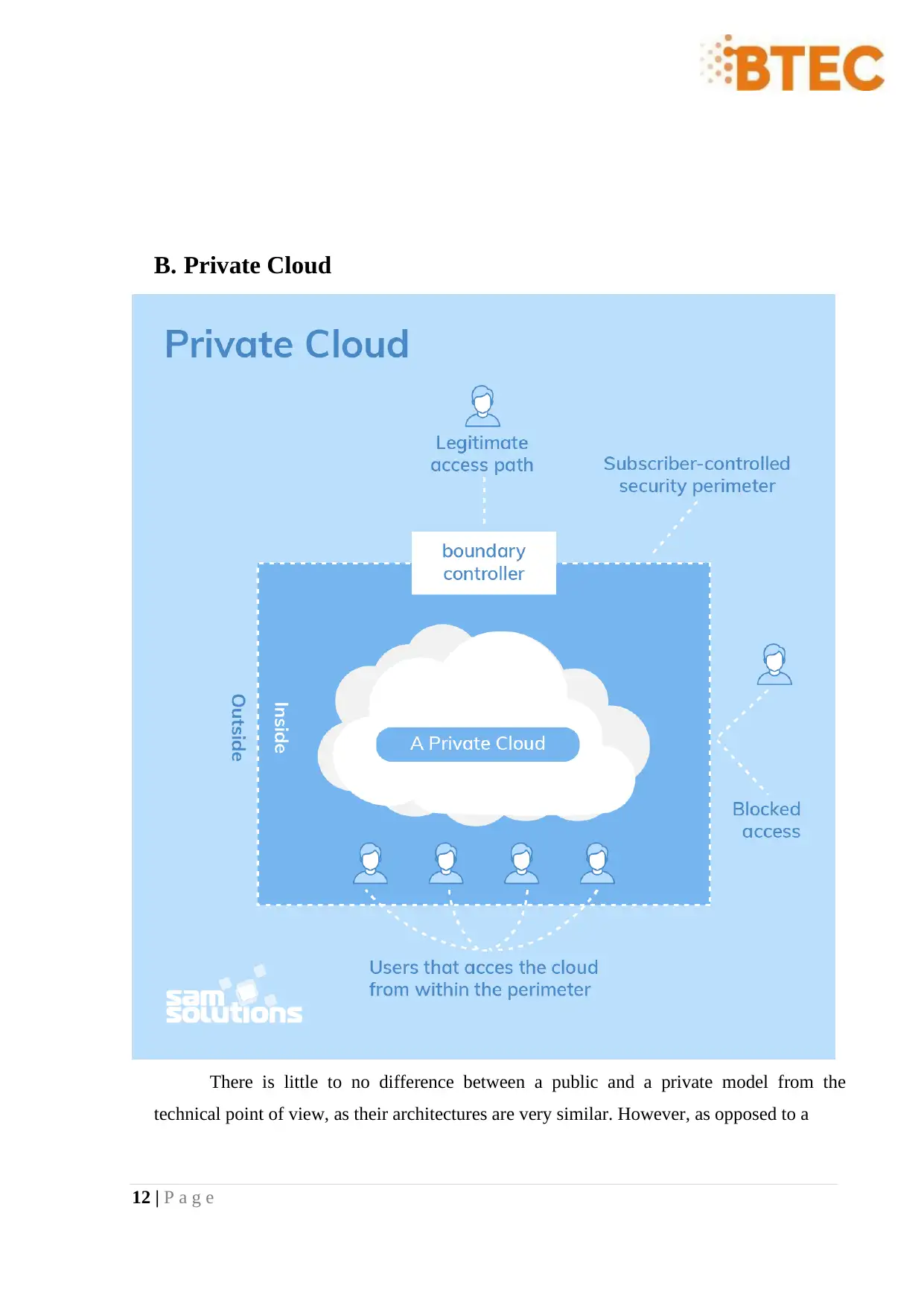
12 | P a g e
B. Private Cloud
There is little to no difference between a public and a private model from the
technical point of view, as their architectures are very similar. However, as opposed to a
B. Private Cloud
There is little to no difference between a public and a private model from the
technical point of view, as their architectures are very similar. However, as opposed to a
⊘ This is a preview!⊘
Do you want full access?
Subscribe today to unlock all pages.

Trusted by 1+ million students worldwide
1 out of 21
Related Documents
Your All-in-One AI-Powered Toolkit for Academic Success.
+13062052269
info@desklib.com
Available 24*7 on WhatsApp / Email
![[object Object]](/_next/static/media/star-bottom.7253800d.svg)
Unlock your academic potential
Copyright © 2020–2025 A2Z Services. All Rights Reserved. Developed and managed by ZUCOL.





